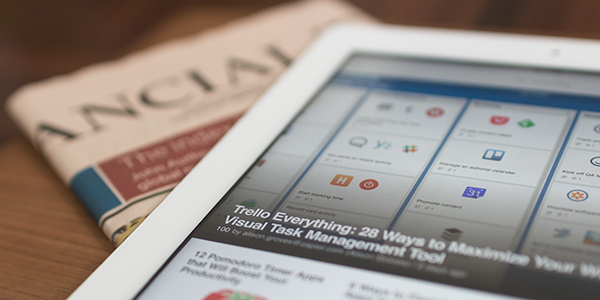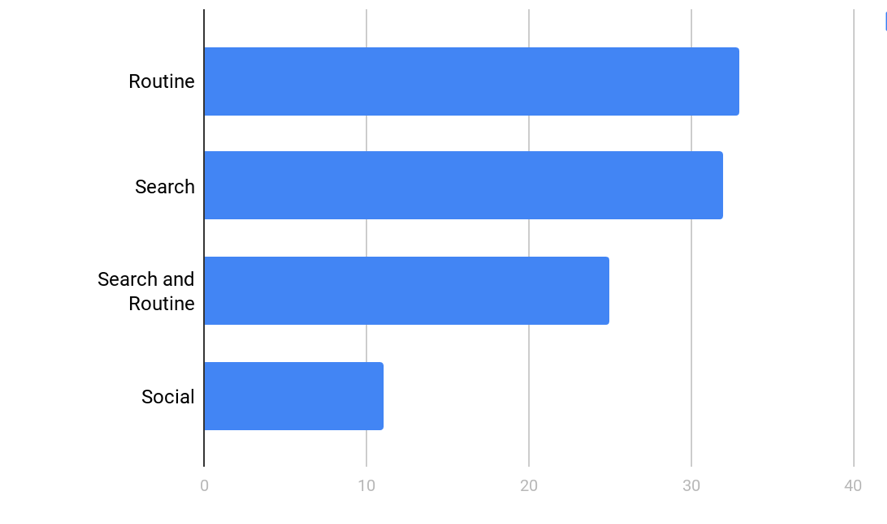News website, search engine or social media? Explaining different pathways to news online
How do we choose where we access news online, and how does this shape how we understand and engage with it? Judith Möller, Robbert Nicolai van de Velde, Lisa Merten and Cornelius Puschmann examine these questions in the context of a fragmented set of online news pathways, and find that levels of political interest and trust are more significant than extreme political opinions for shaping our habits.

Photo by Matthew Guay on Unsplash
Political news serves a vital function in politically turbulent times, and the pathways we use to access news have always had a profound impact on how such news shapes our political views. For example, research from the 1980s and ’90s showed that we remember far fewer and different aspects of news when we watch it on television compared to when we read about it in the newspaper. This is not only a consequence of the technical differences in the devices we use to access political information, but also a result of the specific situation in which users access news, and in their individual motivation to inform themselves about current events. Reading the newspaper while commuting is linked to a different level of attention compared to watching TV news during dinner. Similar mechanisms are at work when we access the news online. In new research we present findings that connect how people encounter news online and their attitudes towards politics and media. Specifically, we want to distinguish between three different kinds of pathways to news content taken by different groups of users.
The first pathway is the simplest: directly visiting the homepage of a news outlet, for example the New York Times or the Guardian. We consider this pathway to be a routine behaviour. As we navigate online, we want to keep informed about current events from time to time. We have a general interest in news and are therefore inclined to head to a news site to keep abreast of current events. The second pathway to news is through search engines: someone is searching the web due to a specific information need (e.g. Where is the nearest dentist? Who will become the next Algerian president?) and then accesses news articles as part of a search result. Similar to routine access, users in this pathway find news through search because of an informational need, but in the case of search this need is much more specific. The third pathway to news is through social media. Research has shown that the share of news on social media is relatively small. Most people do not go to social media for news; instead, much of the exposure to news on platforms such as Facebook and Twitter tends to be incidental.
We wanted to understand why some people prefer one of the three access paths over the others. To achieve this, we tracked 302 internet users in the Netherlands between January 2017 and February 2018 using a browser plugin and combined the data with survey results about their political interest, trust in media, political ideology and polarisation. While the sample is not random, it reflects the Dutch society on background variables such as age, income, and gender.
Based on a cluster analysis, we find that 33% of users primarily access news on the website of a news outlet, 32% have a clear preference for encountering news through search, 25% access news through a combination of news websites and search, together with a small share of social media, and about 11% of users primarily access news through social media. However, we also observe that 81% have encountered news at least once through search, 79% on the homepage of a news outlet, and 50% at least once on a social media site. This means that, according to our data, the majority of news use is rather incidental as part of general information searches and, to a lesser extent, social media experiences. In other words, the routines we have built around offline media use are not mirrored online by a majority of news users.
Figure 1: Cluster size of preferred pathways to news in percent

Drivers of pathway choice
Further regression analysis reveals that news users with higher levels of political interest are more likely to prefer news through social media compared to going straight to news websites. This finding illustrates the importance of motivation to follow current events in the context of algorithmically curated news on social media. Users who frequently read news stories via social media and follow peers interested in current affairs send signals to the algorithm that they enjoy this specific type of content and are therefore more likely to receive it in the future.
According to the filter bubble argument, users with more polarised political views should prefer social media as a source because newsfeed algorithms detect and serve extreme attitudes. Hence, we expected ideological extremism to be associated with a preference for the social media mode. Yet this is not what we find in our data. In fact, we find that political extremism is not associated with any preference for a particular news mode.
We also find a positive relationship between trust in news and a preference for accessing news on the website of a news outlet and a negative effect of trust in media on preference for news gathered through social media. This implies that the more users distrust media the more likely they are to receive news through social media instead of the website of a news outlet.
It is important to note that our findings should be interpreted with caution due to several limitations that result from the way our data were collected and analysed, for example the relatively small and not fully representative sample, the fact that we were not able to include mobile news use, or the fact that tracking users online could have led to more socially desirable behaviour. Having said that, our results are a first exploration of the drivers of choosing how to access news online. In our data analysis, we didn’t find one user characteristic that predicts which pathway to news is chosen. Rather different variable combinations (and presumably underlying user logics) seem to significantly predict a preference for search, social media or routine mode.
This post represents the views of the authors and not those of Democratic Audit. It draws on the authors’ article ‘Explaining Online News Engagement Based on Browsing Behavior: Creatures of Habit?‘ recently published in Social Science Computer Review.
About the authors
Judith Möller is an Assistant Professor for Political Communication at the University Amsterdam. She studies the use of effects of emerging technologies for news use and political information.
Robbert Nicolai (Bob) van de Velde is a Data Scientist & Engineer working on high-quality, diverse and public-value driven recommendations at the Dutch Public Broadcasting Service (NPO).
Lisa Merten is a junior researcher and a PhD student at the Leibniz Institute for Media Research in Hamburg. She is interested in patterns of digital news consumption, customization practices in current digital environments and media effects.
Cornelius Puschmann is a senior researcher and coordinator of the postdoc research group Algorithmed Public Spheres (APS) at the Leibniz Institute for Media Research in Hamburg. His interests include online hate speech, the role of algorithms for the selection of media content, and methodological aspects of computational social science.





 Democratic Audit's core funding is provided by the Joseph Rowntree Charitable Trust. Additional funding is provided by the London School of Economics.
Democratic Audit's core funding is provided by the Joseph Rowntree Charitable Trust. Additional funding is provided by the London School of Economics.